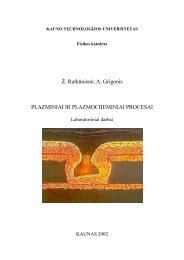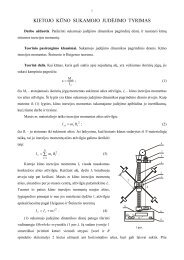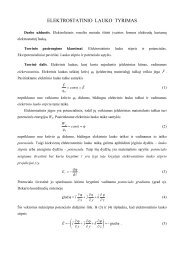PROCEEDINGS OF THE 7 INTERNATIONAL ... - Fizika
PROCEEDINGS OF THE 7 INTERNATIONAL ... - Fizika
PROCEEDINGS OF THE 7 INTERNATIONAL ... - Fizika
You also want an ePaper? Increase the reach of your titles
YUMPU automatically turns print PDFs into web optimized ePapers that Google loves.
G. Adlys / Medical Physics in the Baltic States 7 (2009) 86 - 90<br />
to repair itself and continue to grow. With high LET<br />
radiation such as neutron radiation, the probability for a<br />
damaged tumor cell to repair itself is very small. This<br />
difference is quantified by the relative biological<br />
effectiveness (RBE). For neutrons it is the ratio of the<br />
doses of a reference radiation, usually X-rays and<br />
neutron radiation required to produce the same<br />
biological effect.<br />
For radiation protection purposes, the International<br />
Commission on Radiological Protection, ICRP, has<br />
described the biological effectiveness of radiations by a<br />
series of Quality Factors (ICRP 1977) and by a series of<br />
radiation weighting factors (ICRP 1991). The<br />
Commission chose a value of 1 for all radiations having<br />
low LET, including X-rays and gamma radiations of all<br />
energies. According to the existing ICRP system, the<br />
radiation weighting factors for neutrons are from 5 to 20<br />
in dependence on neutron energy. In medical practice<br />
radiation weighting factor of 3 is used [2] for neutrons.<br />
It means that using neutrons required tumor dose is<br />
about one-third the dose required for photons or electron<br />
treatment. A full course of fast neutron therapy is<br />
delivered in only 10 to 12 treatments, compared to 30-<br />
40 treatments needed for low LET radiation.<br />
It was discovered, that radiations with a high linear<br />
energy transfer (LET) including fast neutrons are less<br />
dependent than X-rays on the presence of oxygen to<br />
produce cell death [3]. It is so-called oxygen effect.<br />
Low LET radiation damage is caused mostly by indirect<br />
biochemical action, formatting of free radicals that<br />
damage the DNA. The presence of free oxygen is<br />
required to facilitate this radiation damage. In the<br />
absence of oxygen the effect of indirect action is limited<br />
[4]. Proliferating tumor cells can reduce the blood<br />
supply to the centre of large tumors. It is reason way<br />
many tumor contained zones have a very low oxygen<br />
tension. Cells that lack oxygen are therefore resistant to<br />
low LET radiations. It causes radio-resistance of cancer<br />
and failure of treatment when conventional radiation<br />
therapy with X-rays is used. To overcome this problem,<br />
high pressure oxygen (HPO) is used in experimental<br />
radiotherapy. Gray and his associates made the<br />
observation in 1953 [3], that the radiation effect on<br />
living cells in anoxia rapidly increases with oxygenation<br />
until it reaches a near maximum effect (40 mm Hg in<br />
normal capillaries and tissues). Further increase in<br />
oxygenation does not appreciably increase the radiation<br />
effect in normal tissues. The influence of oxygen on<br />
radio-sensitivity is expressed as the ratio of the dose<br />
needed to produce a given degree of damage when cells<br />
are anoxic at the time of irradiation to that which<br />
suffices to produce the same damage when cells have<br />
ample oxygen available [4]. The most practical method<br />
of raising oxygen tension in malignant cells was to raise<br />
the partial pressure of oxygen in the respired air. This<br />
proved difficult to administer because patients had to be<br />
placed for long durations within HPO tanks and reduced<br />
choice of angular beam arrangements. Alternative to<br />
HPO was to use high LET radiations such as fast<br />
neutrons. It was realized using cyclotrons to accelerate<br />
protons onto beryllium targets to produce fast neutrons<br />
87<br />
of 7-10 MeV energy. The main therapeutical effect was<br />
achieved due to the recoiling protons and heaver<br />
recoiling nuclei, which increased number of ionization<br />
events along their tracks.<br />
3. The fast neutron therapy<br />
The fast neutron therapy is based on fast neutron ability<br />
to penetrate deeply in to the tissue. More than 20<br />
neutron therapy centers in the world apply these<br />
techniques for treating oncology patients [5].<br />
The dose distribution of high energy neutrons is similar<br />
to those of high energy X ray beams [4]. An additional<br />
advantage of fast neutron therapy lies in the overall<br />
treatment time. When damage to cell is minimal, the<br />
cell can recover following removal of the damaging<br />
stimulus (sub-lethal cell damage). Neutron therapy can<br />
be delivered in much fewer fractions and sub-lethal<br />
damage can be reduced.<br />
Fast neutron beam therapy is more effective in soft<br />
tissue and bone sarcomas [6] and is superior to photons<br />
in high-grade, locally advanced prostate cancer<br />
treatment. Side effects for fast neutron therapy are<br />
similar to those of low LET therapy. Careful,<br />
computerized treatment planning minimizes effects on<br />
normal tissues. Most of the acute side effects are<br />
temporary and normal tissue recovery occurs with time.<br />
Promising development for neutrons is neutron capture<br />
therapy (NCT).<br />
4. The neutron capture therapy<br />
The neutron therapy is presently realized in two<br />
versions: fast neutron therapy and neutron capture<br />
therapy (NCT) [2]. NCT idea was proposed in 1936, 4<br />
years later after neutron discovery. Radionuclide with a<br />
large absorption cross-section for thermal neutrons is<br />
introduced into the patient’s body mainly through the<br />
blood. Reaction products created during neutron<br />
irradiation of patient are affecting tumor cells.<br />
The nuclides used for a neutron capture therapy are<br />
boron and gadolinium at present time.<br />
Naturally occurring stable isotopes of boron are 10 B<br />
(19.9 %) and 11 B (80.1 %). Gadolinium has 7 naturally<br />
occurring stable isotopes. The isotope mass distribution<br />
is shown in Fig. 1.<br />
Composition, %<br />
30<br />
25<br />
20<br />
15<br />
10<br />
5<br />
0<br />
Gd152<br />
Gd154<br />
Gd155<br />
Gd156<br />
Gd157<br />
Gd158<br />
Gd160<br />
Fig.1. Composition of naturally occurring gadolinium<br />
isotopes








